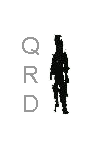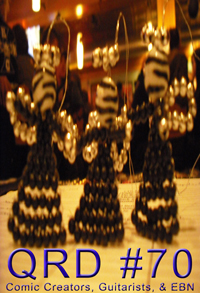
 |
| about
this issue Feature Interview: Electric Bird Noise Guitarist Interviews: Fred Frith Phil Dole Chris Jeely Comic Creator Interviews: Jules Rivera Derek Adnams & Brandon Bullock Graham & Caroline Johnson Martin Malin Mike Rickaby |
 |
 |
 |
 |
 |
 |
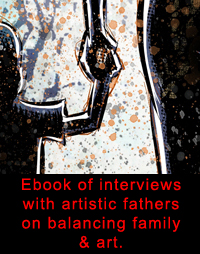 |
|
|
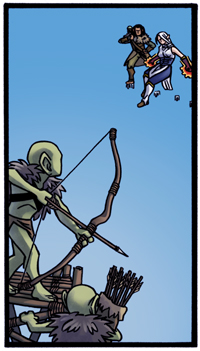 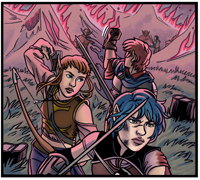 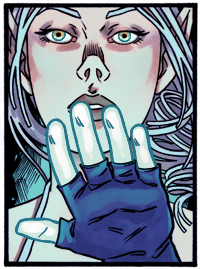 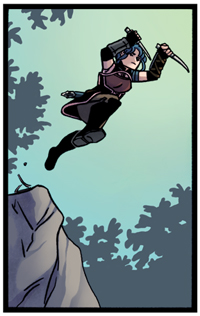 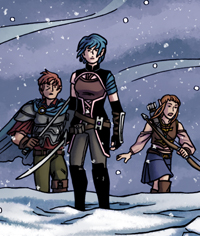 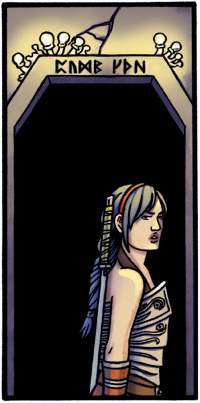 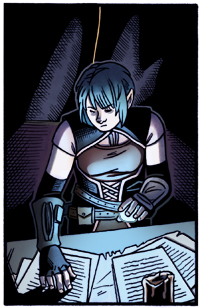        |
December 2014
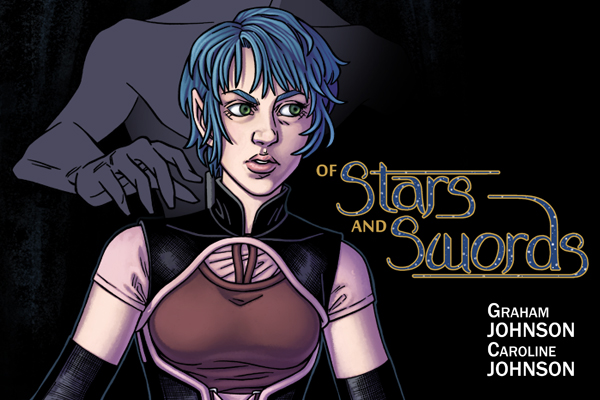
City: Gainesville, FL
Comics: fantasy webcomic Of Stars & Swords, alongside a spattering of completed & in-progress sci-fi.
Websites: ofstarsandswords.com, seriousturtlestudio.blogspot.com, gumroad.com/seriousturtlestudio
QRD – How old were you when you first got into comics & did you always stick with them or did you come back to them?
Caroline – I started reading manga in high school. The first comic I read was a spin-off for the anime Cowboy Bebop. From there, a friend gave me the first volume of Mars (a shoujo series by Fuyumi Soryo) & then I started borrowing whatever manga my friends had. I branched out to Manwha (Korean comics), but didn’t pick up an American comic until college. My first American comics were Watchmen & League of Extraordinary Gentlemen, then I dived into reading the monthly Marvel titles Graham bought. I continue to read comics weekly.
Graham – I read a comic here or there when I was younger & they were kind of always around in some form, but the thing that I really remember were the 90s X-Men, Spider-Man, & Batman animated shows. I would read random X-Men & Spider-Man comics at the time, but most of the ones I had were from older family members & weren’t current at the time. I did read basically everything Star Wars that Dark Horse released, but didn’t firmly get pulled into actual monthly books until the mid-2000s with Civil War.
QRD – What was the first comic book you ever bought?
Graham – I never think I have an answer to this, but it strikes me now that it would have been one of the early Tales of the Jedi issues. I couldn’t tell you the exact one, but those got me completely hooked on Star Wars comics.
QRD – How old were you when you put out your first comic?
Caroline – I had a webcomic that I started in high school & updated through college. I think I was 16 when it started. But I wasn’t serious about the work I was putting out until I was 21. Graham & I put together a short sci-fi comic. It was our first collaboration & a whole different beast for me. It’s still available for free on our Gumroad.
Graham – I was drawing dumb superhero comics in elementary school, but those barely count. Like Caroline, I had a webcomic in high school as well. It ran for about 2 years of kind of dumb jokes before I quietly walked away from it. I messed around with concepts, but didn’t really do anything seriously until the comic Caroline & I did together.
QRD – What decade do you think produced the best comics?
Graham – It feels like cheating, but I’m going to pick this one. There is so much gold out there from the Big Two to Image to other indie books to the web that it’s just insane. There were great comics produced all the time before now, but with the diversity & ability for anyone with an idea to just go for it thanks to the web that I feel like we’re living in a golden age.
QRD – Why comics instead of just writing or drawing?
Caroline – I’ve tried both independently. For me, storytelling is not something I can do with words. Even my favorite movies let the actors communicate with actions instead of dialogue. & I’ve never been able to draw without a prompt.
Graham – I wrote a lot of prose for years. I still do, but not as frequently anymore. While Caroline does the art for our comics right now, I’ve been drawing all of my life as well. At some point in college, it just made far more sense to me to put them together. When I write, I’m very focused on visuals & seeing, so it just works to actually combine the two. Comics is also far better for what I like working on than say TV or movies, because I like to see inside the character’s head in a way that you can’t really do in those mediums. Comics just fits how I want to tell stories.
QRD – Do you see mini-comics & indie comics as paths to mainstream comics or as their own unique media?
Caroline – Both. I think Indie & short stories are a great place to try new things out, experiment, test ideas that wouldn’t work elsewhere. It’s a great way to gain experience at your own pace & to feel out your strengths & weaknesses. At first, doing our own comics was just portfolio building for finding work-for-hire, but I have grown to really appreciate the creative control we have to make the kinds of stories we want on our own terms.
Graham – Exactly what Caroline said. I’ll just add that while I absolutely would love to do mainstream work one day, that’s a completely different headspace for me compared to our own stuff. I’d never want to give up doing my own thing with characters that are completely mine in whatever format I feel like fits the particular story.
QRD – How many copies of your comic do you print in your first run?
Caroline – 25. Just to have something to sell at a convention. However, our focus has shifted to digital sales, with Comixology & Gumroad.
QRD – How much do you think comics should cost?
Graham – Enough so that the creators don’t die & can keep telling the story they want to tell. I do share the frustration of comics costing more, but these things happen. & considering how much amazing art can be contained in just 20 odd pages of a comic, even $5 is a steal when you think about it.
QRD – How many books do you produce a year & how many would you like to?
Caroline – Currently, we put out about two issues worth a year. One page a week when Of Stars & Swords is actively updating (we’re on a hiatus right now while we build the first trade & plan out some smaller interim projects). I’d love to do more, but it’s a balance between quality & quantity & I will always choose making a comic look better over getting it out quicker.
Graham – To the how many I’d like to do, the answer is absolutely more. There are some non-Of Stars & Swords things I’d like to do, one of them just dependent on me kicking myself & working harder to do it myself. But I definitely agree on quality being more important, so I’m okay with Of Stars & Swords being a bit slower due to the weekly release schedule.
QRD – Do you think stories should be serialized or delivered as complete works?
Caroline – It depends on the story. Some stories are suited better for one sitting. I know it was a challenge at first for Graham to figure out how to pace Of Stars & Swords so that each page could stand on it’s own for a week before the next update. Both formats have their own challenges when it comes to pacing & layout.
Graham – If a story is delivered in both formats, you need to at least attempt to succeed at both.
QRD – How are comic strips different than comic books & which medium do you prefer?
Graham – In my mind, they aren’t all that different beyond the physical structure. I do tend to prefer the shape that a page in a book allows rather than the horizontal focused strip. I don’t really divide them up by subject matter in my head because that’s an arbitrary thing that the form itself doesn’t dictate. Really, comics are comics.
QRD – How long is it from when you start a comic until it’s printed?
Graham – Because of how we work, it’s difficult to say. For Of Stars & Swords, I generally have the entire arc outlined months ahead of time & then try to get as far ahead on the actual scripts so that I’m doing small edits as Caroline is drawing them.
QRD – What do you do better with your comics now than when you first started?
Caroline – Rendering & acting. Backgrounds were a real struggle for a while. Faces were bland & inconsistent. Because of my autism, I really struggled with how to pose characters & have them emote in any communicable way. I spent a lot of time studying faces & body language.
Graham – I feel like I more or less know what I’m doing telling a story now. I wasn’t quite sure of that when we started. I can be a bit wordy when writing & I think I’m getting better about that, but that’s still something I have to be aware of.
QRD – Do you do thumbnails?
Caroline – Graham usually does thumbnails for me since he has an idea in his head from writing. It gives me a starting point even if I don’t like how he set things up. I find it much easier to edit an idea (or throw it out & do something different) than to start with nothing.
QRD – At what size do you draw?
Caroline – I draw on 11x17 lined comic boards.
QRD – What kind of pens do you use?
Caroline – I use a Speedball 102 Crowquill dip pen with a mixture of FW acrylic & Liquitex black inks.
QRD – What does your workstation look like?
Caroline – I mostly work at my computer desk, with reference onscreen. I keep my supplies in bins on a table next to my computer. I have trays & cups for ink & water mixtures & a stack of napkins for accidents. I keep a pencil, some pens, clear rulers, a square of transparency film (to rest my hand on), & a mirror (for quick reference) at my desk at all times.
Graham – I also work at my computer desk. I’ve got two monitors, so writing tends to mean one is filled with the script & the other will have music playing & research on it. I’ve also got a sketchbook & pencils next to me to do the layout work.
QRD – At what point in the artistic process do you work digitally?
Caroline – As soon as the inks are done I switch to digital to clean everything up & color. I also do layouts digitally for covers & spreads & then trace them on to art boards. I have a hard time drawing big without stuff getting warped or stiff-looking.
QRD – What do you think of digital comics & webcomics?
Caroline – I think they’re pretty rad. The cheapest, lowest-risk method for getting your work into as many hands as possible, all over the world, with very little financial risk, all while remaining in complete control of your IP (usually).
Graham – Digital is a godsend for comics. The madness of printing & distribution is gone & someone that wants to make a comic can just...make a comic now. Places like Tumblr even mean you don’t have to pay for webspace, though that format isn’t terribly great for reading. The only real difficulty is being seen in the mass of everyone else, but that exists in one form or another anyway.
QRD – Do you prefer working in color or black & white?
Caroline – I enjoy both black & white with painted greyscale & working in color. I mostly work in color because I think it’s more marketable & it doesn’t affect us much cost-wise since our distribution is primarily digital.
Graham – I love black & white done well, but everything I write I see in my head in color so that’s what I aim for.
QRD – How many different people should work on a comic & what should their jobs be?
Caroline – As many as want to & whatever they want to do.
QRD – How do you find collaborators?
Caroline – I married mine. :P
Graham – She married me.
QRD – How tight do you think a script should be as far as telling the artist what to draw?
Caroline – Whatever the writer & artist finds works best for them. Graham writes pretty open scripts for me, but I have the luxury of being able to call him over & talk out any scene while drawing it.
Graham – I don’t like the idea of there being no room for the artist to do what they want in a script. I do script Of Stars & Swords pretty tightly, but only because I think that way & I’ll usually pull back on things that are too nitpicky unless there’s a vital reason to mention it. Scripts I write for myself to draw are different in that they’re very specific & I’ll sometimes use shorthand to remind myself of the headspace I’m in when I come back to draw, but those aren’t things I can or would do to another artist.
QRD – Do you think it’s important to have a full story arc completely written before starting to draw?
Graham – If the story is a major part of the comic, it’s a good idea to know where you’re going, at the very least. For how I work, I always have my ending first. Sometimes in great detail, sometimes as just a rough goal. The outline I do is figuring out the middle & then I can script without too much trouble.
QRD – What comic book person would you be most flattered to be compared to?
Caroline – Becky Cloonan. She draws some gorgeous men & ladies.
Graham – Jonathan Hickman. The stories he writes are so ridiculously well plotted & intricate. His notebooks are the stuff of legends for me.
QRD – What do your friends & family think of your comics?
Caroline – I’m not really sure? They don’t really mention it except to guilt me for always being busy drawing. I guess most people see it as something I just do without understanding what it entails. My mom apparently corners strangers who have even the loosest connection to comics, art, or comics culture to brag about me.
Graham – A few friends at least keep up with what we do & are really supportive, so that’s nice. Family is a weird thing, but they’re not actively trying to stop us so I can’t complain too terribly much.
QRD – What do you think of superheroes?
Graham – Love ‘em. I especially like that it’s becoming more & more common to not treat superhero as a genre & instead let the different heroes really have different kinds of stories. Mainstream comics definitely needs to be more than just superheroes, but that seems to be happening slowly & I’d never want to see them go away completely.
QRD – Marvel or DC?
Caroline – Marvel. I’ve tried really hard to enjoy the DC-verse over the years, but have never found the settings, characters, & scenarios compelling; with some exceptions of course.
Graham – Marvel, as well. There are some DC characters I like, but I just gravitate right back to Marvel most of the time.
QRD – What comic characters other than your own would you like to work with?
Caroline – I really want to do a Lady Sif & the Valkyries book. Just a bunch of lady warriors kicking ass & taking names. Doctor Strange, Red Sonja, Ms Marvel (the new one), & a few that I’m forgetting right now...
Graham – Nova. Sure, his powers are basically Marvel Green Lantern but I love the character & his look & I’d love a crack at him. Others that spring to mind immediately are Spider-Girl (Anya Corazon), Winter Soldier, X-23, Black Widow, Doctor Strange, Iron Fist, Cyclops, Doctor Doom, uh... a lot. The truth is, I’d be happy to write damn near any established character just to see what I could do.
QRD – Ideally would you self-publish?
Caroline – I love the idea of self-publishing. But we’ve run into the main hurdle with it: you are completely on your own with no one to help promote your book. We’ve considered crowd-funding finished projects, but the legitimacy of a publisher is much more ideal at the moment. Maybe when we have a larger base to draw from we will push self-publishing more. For now, having a webcomic mostly fulfills that.
Graham – Even if we’ve only done smaller print runs of our comic & focused on digital, I would say we do self-publish & that’s all we’ve ever done. It’s great having full control, but that can be just as much a curse for obvious reasons.
QRD – What conventions do you try to attend & why?
Caroline – We try to focus on specific cons where we can meet other creators & maybe make editorial contacts. We used to go to MegaCon in Orlando, but their focus is on media guests & there are fewer comics people & even less indie creators. We scoped out HeroesCon in Charlotte this past June & loved it. Not much of an editorial presence, but we met a lot of indie creators & enjoyed how focused & relaxed the con was. It doesn’t hurt that Charlotte is a beautiful city. C2E2 & Emerald City are on the short list of cons we need to check out.
QRD – How do you feel about doing work for anthologies?
Caroline – I enjoy doing short stories to try new things I can’t do with Of Stars & Swords. I’m always looking out for good projects to get involved with, though I haven’t done any yet. Graham & I currently have a collection of sci-fi themed stories we’re working on & we’re kinda handling it like an anthology, just with only us so far.
Graham – Anthologies are great. We’re doing the sci-fi collection because it’s basically an anthology we can do just by ourselves. I love being able to tell a bunch of small stories with a similar theme. Plus, shorter comics are always a fun challenge.
QRD – What do you do to promote your books?
Caroline – I’m semi-active on Twitter, we have a Facebook page for Of Stars & Swords, we send out press releases when we reach comic milestones, & place fliers in local shops & mail more off to friends to put in theirs.
Graham – In addition to all of this, I literally do not shut up on Twitter. I am always there. Promotion happens in between me generally being an idiot there.
QRD – Do you think your comics are well suited to comic shops or would sell better elsewhere?
Graham – Like most things, it depends. I’d like to think that Of Stars & Swords fits nicely into the current push for more comics with female leads that aren’t ridiculous, but even that isn’t going to fit into all shops everywhere.
QRD – What other medium would you like to see some of your comics made into (television, film, games, action figures, etc.)?
Caroline – A Korra-esque Of Stars & Swords series would be the dream, but I’m too much a realist to expect it would ever happen.
Graham – I wouldn’t be against an animated show like Caroline mentions or a movie or anything, but I have trouble seeing it. The characters have such strong voices & ways of doing things in my head that I just can’t see that in another medium where I can’t hover over everyone & tell them how wrong everything they’re doing is.
QRD – Do you consider yourself a comic collector or a comic reader or both?
Caroline – Reader. Graham’s hunted down a few issues that were important to him, but otherwise comics are for reading.
Graham – Even with the issues of things I’ve hunted down, I’m a reader. & a re-reader. Also a re-re-reader.
QRD – What do you see as the most viable mediums for comics distribution 10 years from now?
Caroline – BEAMED DIRECTLY INTO THE BRAIN. Digital is probably going to eventually win out as a primary distribution model, especially if sales of single issues don’t suddenly pick up again. I just don’t see the print model as financially viable with current sales numbers; but at the same time, digital’s hurting because there’s this perception that something non-tactile has less value somehow -- even though it’s more convenient, more accessible, & you don’t have to worry about storing it after reading.
Graham – I don’t think print’s going anywhere in the next ten years. Digital’s going to keep growing & hopefully become more legitimate to a lot of people, but I don’t see it killing print just yet. Plus, as much as I will fight hard for digital, I’m always happy to have something physical in my hands when I read.
QRD – What would you like to see more people doing with comics?
Caroline – Having fun with it & taking ownership of their work. I like seeing more creators juggling work-for-hire & creator-owned. I think it gets you more involved in the process, keeps work from getting static. I think Marvel & DC have both benefited from bringing in non-conventional creators with experience doing their own thing. I have a hard time shelling out for Big 2 comics when everything looks the same & the stories all have the same bland structures.
Graham – Less bandwagon jumping & more going for what you really want to make. Of course, the current market seems to be going that way, so I’m pretty happy. Even the Big Two are diversifying the types of stories they tell & how they look. The less everything looks the same & tells the same story, the better.
QRD – Anything else?
Caroline – Buy our comics & follow us on Twitter (@cjohnsonart for me & @jyrenb for Graham)! If, -ahem- when, anything exciting happens, you’ll hear about it there first!
